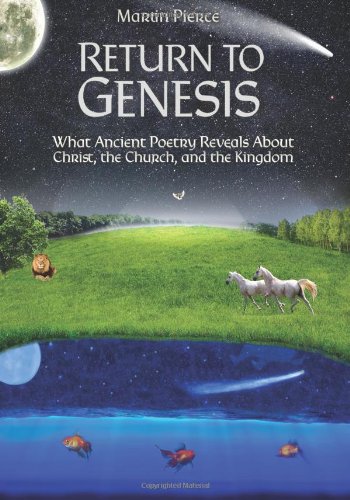Book review: Return to Genesis
by Martin Pierce
★★★★
Wow, this book is HUGE! Pierce is opinionated and has lots to say, so there is no way a short Dubious Disciple review could touch on every topic he covers. It was a roller coaster ride; oddly, I usually either strongly agreed or strongly disagreed with each topic. Yet the writing was too captivating to merely skim.
Well, with one exception. Be forewarned about a chapter titled The False Israel in which Pierce attempts to knock Jews off their high horse. He complains about how much financial, political and media influence Jews have, and pooh-pooh’s their belief about being the chosen race (while he simultaneously promotes only Christians as God’s children.) This chapter just drones on and on and on, describing the evils of Judaism, and may be skipped.
The book’s subtitle is What Ancient Poetry Reveals About Christ, the Church, and the Kingdom. It officially reaches the stated topic in part five (there are six parts in all). While the reading before this section is interesting, I think Pierce errs in thinking his readers need that much preparation (indoctrination?) before getting to the good stuff. But now that we’re there, take a gander at these two verses:
Genesis 1:1, the beginning of the first creation story: In the beginning God created the heaven and the earth.
Genesis 2:4, the beginning of the second creation story: … in the day that the LORD God made the earth and the heavens.
Did you notice the difference? One tells the story looking down from heaven; the other, looking up from the earth. When heaven comes first, it results in the Sabbath rest. However, when the earth comes first, it results in the Fall. These two stories, insists Pierce, are intentionally complementary; they could not be by two different authors, as proponents of the Documentary Hypothesis claim. For proof, Pierce lays out each story’s structure and shows us how the pieces fit together: Genesis 2:4-2:25 is a reworking of 1:1-2:3, with a different emphasis, so that we can understand the same set of events symbolically. One from the viewpoint of heaven, and one from earth. This is a quite fascinating observation, and Pierce’s research is worth studying. But will digging into the symbolism really help us understand the Bible in a more meaningful manner?
I think so. For an example, try picturing Eden, a little garden in the midst of a world of pain (Adam and Eve were hardly alone in the world), with a river flowing out of it. Revelation describes this river as flowing out from the throne of God. The river divides into four smaller rivers; “four” symbolizes completeness, as the pure water of Eden flows out to the four corners of the earth. Does this describe the Kingdom of Heaven that you have in mind, as you picture God’s will for this world? (Think spiritually, not in a natural sense.)
Martin Pierce is a relatively conservative Christian—for example, he adheres to traditional authorship of the New Testament, but thinks it’s silliness to believe in young-earth creationism against overwhelming evidence—yet he is not very enamored of the current trend of Biblical literalism. This is not to say that Pierce doesn’t take the Bible seriously or that his interpretation is extreme. In my opinion, it’s not. He simply believes the Bible’s real purpose is in its theology, not its history. He subscribes to partial preterism (meaning that most, but not all, of the bible’s prophecies such as the Day of the Lord came to pass as expected in the first century) and post-millennialism (meaning, in this case, that Jesus will come back yet a third time).
More than anything else, this perspective means Christians who live with their head tilted skyward waiting for the return of Christ should instead lower their gaze to a world that needs their attention. It only takes a small number of Christians to make a difference, but they must be faithful. The parable of the ten virgins helps explain how we should view the earth. The five foolish virgins weren’t condemned for not being ready—indeed, they WERE ready at precisely the right time—but they were condemned for being unprepared for an unexpected delay in the coming of the bridegroom. Likewise, we should never approach life as if we’ll only be around for a few more years, as this only encourages improper stewardship of the earth.
So is this the “right” way to read Genesis? Did its author(s) intend for us to recognize the various chiasms and parallelisms in its text? Do symbolism, metaphor and typology play as large a role as Pierce describes? Heck if I know, but I do know I enjoyed the study. It’s a fascinating and meaningful way to make sense of a book that many may otherwise find full of only antiquated myth.
Pierce’s book is a call to return to the state of purity and blessedness that existed in the garden of Eden. That requires unity, but the Eden Pierce imagines is Christian unity, not worldwide unity. And for this, he has a plan. A governing council of perhaps seventy elders would represent and unify the various denominations, while keeping a strict watch for heresy. Each would be in agreement with at least the Nicene Creed and the Apostles’ Creed, and no dispensationalists or literalists (such as young-earth creationists) would be allowed to hold a position on the council. The represented denominations would be governed so that sinful practices such as homosexuality would never be tolerated. A Christian court would be established, as this world needs Christian representation in such issues as divorce and child custody. Yeah, you can guess it ended on a “strongly disagree” note for me … but I still recommend the book as insightful and interesting.












 354 Circles
354 Circles
 603 Goodreads Friends & Fans
603 Goodreads Friends & Fans

 Hello! I'm an author, historical Jesus scholar, book reviewer, and liberal Christian, which means I appreciate and attempt to exercise the humanitarian teachings of Jesus without getting hung up on any particular supernatural or religious beliefs.
The Bible is a magnificent book that has inspired and spiritually fed generations for thousands of years, and each new century seems to bring a deeper understanding of life’s purpose. This is true of not only Christianity; through the years, our age-old religions are slowly transforming from superstitious rituals into humanitarian philosophies. In short, we are growing up, and I am thrilled to be riding the wave.
I avidly read all thought-provoking religion titles. New authors: I'd love to read and review your book!
Hello! I'm an author, historical Jesus scholar, book reviewer, and liberal Christian, which means I appreciate and attempt to exercise the humanitarian teachings of Jesus without getting hung up on any particular supernatural or religious beliefs.
The Bible is a magnificent book that has inspired and spiritually fed generations for thousands of years, and each new century seems to bring a deeper understanding of life’s purpose. This is true of not only Christianity; through the years, our age-old religions are slowly transforming from superstitious rituals into humanitarian philosophies. In short, we are growing up, and I am thrilled to be riding the wave.
I avidly read all thought-provoking religion titles. New authors: I'd love to read and review your book!
 Hi! While Lee writes the articles and reviews the books, I edit, organize, and maintain the blog. The views expressed here are Lee's but I'm his biggest supporter! :-)
Hi! While Lee writes the articles and reviews the books, I edit, organize, and maintain the blog. The views expressed here are Lee's but I'm his biggest supporter! :-)
Connect With Me!